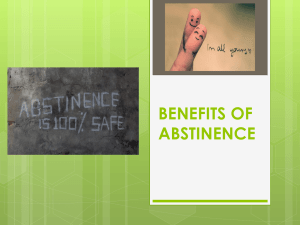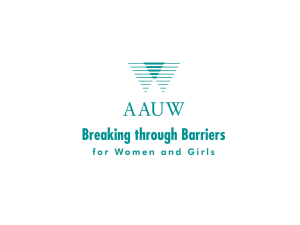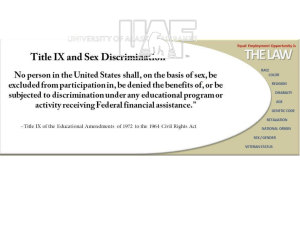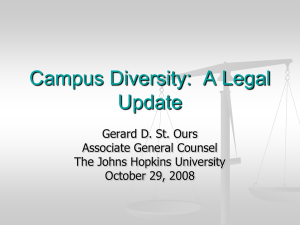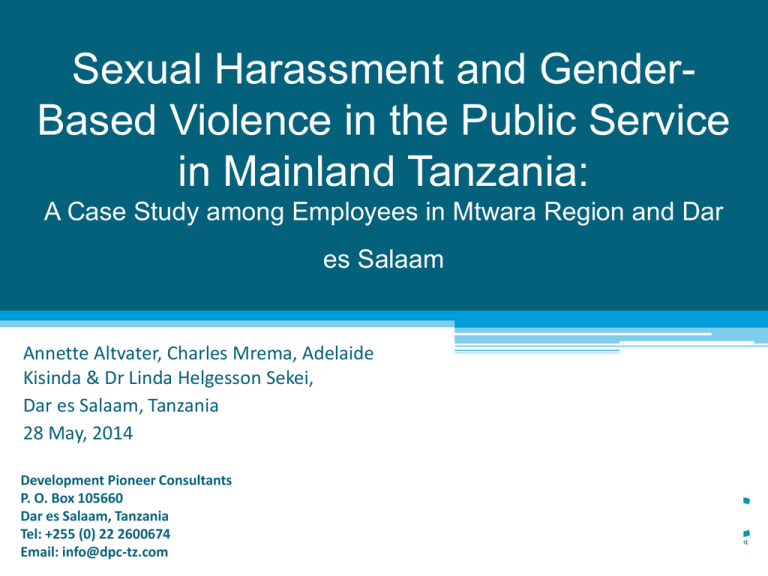
Sexual Harassment and GenderBased Violence in the Public Service
in Mainland Tanzania:
A Case Study among Employees in Mtwara Region and Dar
es Salaam
Annette Altvater, Charles Mrema, Adelaide
Kisinda & Dr Linda Helgesson Sekei,
Dar es Salaam, Tanzania
28 May, 2014
Development Pioneer Consultants
P. O. Box 105660
Dar es Salaam, Tanzania
Tel: +255 (0) 22 2600674
Email: info@dpc-tz.com
What is Sexual Harassment?
Sexual harassment includes:
intimidation; bullying or coercion of a sexual nature; and
unwelcome or inappropriate promise of rewards in exchange
for sexual favours. It can also include unwelcomed sexual
advances, requests for sexual favors, and other verbal
(offensive comments or offensive comments about a person’s
sex) or physical violence of a sexual nature.
Objectives
1. Identify and describe public service policies, strategies and other
frameworks that cover sexual harassment and gender-based violence.
2. Assess public servants awareness of the Code of Conduct and Ethics
and whether or not the workplace programme (WPP) has also covered
the area of sexual harassment.
3. Measure the magnitude and manifestation of the problem of SH-GBV
and to develop a better understanding of the existing situation at the
public workplaces.
4. Develop a better understanding of the causes and consequences of
sexual harassment and violence at public workplaces.
5. Explore if there exists a link between SH and the transmission of HIV and
other STIs at the workplace.
Background of the study
W
P 2007
P
(
P
O
P
S
M
)
-
2011
SH-GBV
(Evaluation)
2011
GiZ: IDS (UDSM): Survey
2012/13
DPC:Additional analysis
& FGDs
Study design and methodology
Methodological approach
• Linked to the WPP and streamlined with the WPP activities at the
ministry, district and ward levels.
• Structured questionnaire through face-to-face interviews with 629
women and 964 men. (IDS)
• Additional analysis (DPC)
• Additional Focus Group Discussions (DPC & PO-PSM)
Majority have participated in WPP activities
Gender comparison and rural and urban comparison
Research instruments
Three different instruments were used to collect data on
the study population of public servants:
• Individual, anonymous questionnaire
• FGDs on districts and ward levels
• Key informant interviews
Sampling design
Stratification of study population of public servants in Mtwara into;
•
•
Urban sub-group: Had participated into in WPP one year prior to the survey
Rural sub-group: At the time of the survey were implementing WPP
Further subdivided into;
• Male public workers
• Female public workers
Male
Urban
Rural
further subdivided
Female
purposive or convenience sampling
Background of the respondents
Questionnaire, face-to-face
A total of 1593 respondent took part in this
survey:
•
•
•
All respondents were public servants.
Majority had participated in WPP
before
Skewed towards male: 924 were male
and 629 female
Skewed towards rural: 940
respondents were from rural areas.
FGDs and Individual interviews
A total of 8 FGDs and 3 key informant
interviews.
•
All respondents were public servants
•
Gender balanced: 4 FGDs with male
and 4 with female.
•
4 in rural and 4 in urban
•
Each FGD had around 8 participants.
•
3 key informant interviews: 2 in Dar es
Salaam and 1 in Mtwara
Limitations of the study
• Slightly different questionnaires for male &
female
• Assumption on female victims and male
perpetrators
• Answer options related to the assumption
• Gender comparison limitations
• Assumption on definitions
Findings of the study
Organised in a manner that is in line with each of the
study objectives;
1. Awareness of the code of conduct and ethics for public
employees.
2. Dimensions and magnitude of SH-GBV at public
workplaces.
3. Causes of SH-GBV at public workplaces.
4. Link between SH-GBV and HIV/STIs at public
workplaces.
5. Conclusions and recommendations.
Awareness of the Code of
Conduct and Ethics for Public
Employees
Male and female respondents’ awareness of the Code of Conduct
and Ethics for Public Employees
Why code of Conduct and Ethics
for Public Employees?
More men are aware of the
Code of Conduct for Public
employees than women.
•63% of men report to be
aware.
•48% of female respondents.
admitted to be aware.
Click to edit the outline text format
Second Outline Level
Third Outline Level
Fourth Outline Level
Fifth Outline Level
Sixth Outline Level
Seventh Outline
Level
Eighth Outline Level
Ninth Outline Level
Male and female respondents’ initial source of
knowledge for the Code of Conduct and Ethics for
Public Employees
WPP seems to be the major source
for both;
•34% of women
•A relative high % of males (48%).
•Other government programs
•Directors and other officers
mentioned, but seem to be the least
source of knowledge for both male
and female respondents.
Click to edit the outline text format
Second Outline Level
Third Outline Level
Fourth Outline Level
Fifth Outline Level
Sixth Outline Level
Seventh Outline
Level
Eighth Outline Level
Ninth Outline Level
Awareness of WPP intervention
• Well known from FGDs
• Referred to as a programme that was implemented once per year for one to two
days
• Mainly covering the topic HIV/AIDS awareness, prevention and care.
• Not all had participated, but expressed a demand for such trainings:
WPP includes all departments but there are few opportunities so it depends on how the groups
are arranged (participants selected) from year to year. But it only includes a few people from
the different departments. This is something which needs to be improved (Female FGD, Dar
es Salaam, ward level).
For us who attended the seminar it has helped us. But if it could have included people from all
departments, it could have been more useful (Female FGD, Dar es Salaam, ward level).
Magnitude and manifestation of
SH-GBV at public workplaces
Meaning of SH and SV from respondents’
perspective
Respondents from the actual survey were assumed to understand the meaning
and the difference between the terms Sexual Harassment and Sexual Violence
In FGDs the meaning and difference was explored.
Sexual favors such as agreeing to have sex with someone in return for financial
or social gain at the workplace is considered as sexual harassment, while rape,
beating and foul language was considered as sexual violence:
To me I think there is a difference. Sexual violence is more than sexual
harassment. For example if my boss wants me to offer him sex so that I can
get good treatment at my workplace then that is sexual harassment. But if I
refuse and he reaches an ultimate point of raping me, then that is sexual
violence (Female FGD, Mtwara urban).
Female respondents’ reporting having been sexually
harassed at their workplace
• 20.51% of women report
to have been sexually
harassed.
• 72.97% report to not been
sexually harassed.
Click to edit the outline text format
Second Outline Level
Third Outline Level
Fourth Outline Level
Fifth Outline Level
Sixth Outline Level
Seventh Outline
Level
Eighth Outline Level
Ninth Outline Level
Female respondents’ reporting having been sexually
violated at their workplace
•
2% report to have been
sexually violated
•
40% of women report to
not been sexually violated
at their workplace
•
58% not indicated
Click to edit the outline text format
Second Outline Level
Third Outline Level
Fourth Outline Level
Fifth Outline Level
Sixth Outline Level
Seventh Outline
Level
Eighth Outline Level
Ninth Outline Level
Male respondents’ reporting having been sexually
harassed/sexually violated at their workplace
•
12% of men indicated to
have been sexually
harassed.
•
4% of male respondent
said to have been sexually
violated.
Click to edit the outline text format
Second Outline Level
Third Outline Level
Fourth Outline Level
Fifth Outline Level
Sixth Outline Level
Seventh Outline
Level
Eighth Outline Level
Ninth Outline Level
Causes of SH-GBV at public
workplaces
Perceived causes of SH-GBV at workplaces testified by men
Majority of them believe that women’s behavior is the cause of sexual
harassment.
• 46.4% women’s dressing styles
• 37.0% women’s monetary needs
• 36.2% women behavior of seducing men
• 16.6% environment created by the current management system
• 10.4% women being unaware of their rights as Public servant
• 9.4% It is usual for men to want sexual friendship with women at the
workplace.
• 8.9 % unaware of the principles of ethics regarding SH-GV in the public sector
workplace is the cause.
Perceived causes of sexual harassment at workplace from
FGDs
Causes of SH-GBV was among the
issues explored in the FGDs.
•
Men living away from their
wives
•
Women dressing styles which
are not in line with the
Government Dress Code
•
Some men believe that women
dressing style should not taken
as an excuse
.
“To me I can say that though the issue of
dressing is regulated in public sector but
still the situation is not good enough.
Some women still do not wear decently.
They put on clothes which shape their
bodies which make it easier for men to
be tempted” (Female FGD, Masasi
district).
“The government is trying hard on the dress
code at workplace. What remains is
upon us men because even when a
woman put on a hijab dress, men still
would like to get to know her” (Male
FGD, Dar es Salaam, ward level)
Consequences of sexual harassment and
remedial measures
•
Fear
•
Inefficiency at work
•
Low productivity,
•
Poor work relations,
•
Loss of employees.
•
Transmission of diseases e.g. HIV &
STIs
•
Public image may suffer especially if
reported cases are not dealt with
adequately.
•
Sexual harassment can damage
work environment - employees being
uncomfortable working in such
environment
“A person who has been harassed will
no longer be normal she/he will
develop a certain worry towards
the perpetrator that maybe if I
deny him/her this time while I have
already had sex with him/her ten
times before, then what will be
next?” (Female FGD, Dar es
Salaam, district level)
Remedial measures from questionnaire
The top six measure suggested by women:
• Stronger punishment of harassers.
• Regular seminars focusing on the code of conduct
and ethics.
• Raising of salaries for women.
• Monthly secret vote on casting to reveal leaders
who sexually harass their subordinates .
• Women should be decently dressed
• Increased sensitization and knowledge sharing on
HIV.
Remedial measures from FGDs
•
Encourage women to be confident
•
Use suggestion boxes
•
Empower PCCB
•
External psychologist or institution to deals with SH-GBV cases
•
Sensitization workshops on what SH-GBV is, as well as the laws and
regulations that are in place
•
Documentation of reported incidences which can be used to take to the
next level
•
More training on awareness SH-GBV media (radio and TV)
•
Appointed officers should have a professional background in social
behavior
•
A system which issues written warnings to perpetrators
•
Laws and regulations are in place but need to be reinforced
Link between SH-GBV and
HIV/STIs at public workplaces
Fear of having been infected with HIV as a result of
SH-GBV
•More men who are sexually harassed from rural areas
feared having contracted HIV than men from urban areas.
•A few sexually harassed women also fear to contract HIV.
Does sexual harassment and gender
violence contribute to the spread of
HIV/AIDS in public workplaces?
Male and female opinions on whether SH-GBV
contributes to the spread of HIV at public workplaces
Majority of men and women
believe that SH-GBV contributes
to the spread of HIV.
•79% of male
•71% of female
•
Click to edit the outline text format
Second Outline Level
Third Outline Level
Fourth Outline Level
Fifth Outline Level
Sixth Outline Level
Seventh Outline
Level
Eighth Outline Level
Ninth Outline Level
Linkage SH-GBV & HIV at public workplaces –
testimonies from FGDs:
• It even happens to teachers whereby head teachers use the
capitation money to seduce teachers and make them close to him
by telling them that he will give them some amount of money. For
instance at school A, the headmaster had such tendencies and he
had sexual relationship with many teachers, who some of them even
died (Female FGD, Dar es Salaam, ward level).
• I was told that such actions persisted in the past when I was
transferred to this office from Mtwara District Council about a year
ago. I was told that there were some bosses who used to harass
junior workers sexually and that some of them have already died
(Key informant interview with HR manager, Mtwara urban).
Conclusions and recommendations
Conclusions and lessons learned
•
A significant portion are not aware of the existence of code of conduct.
•
Both women and men are said to be victims of sexual harassment.
•
The main perpetrators tend to be men with administrative power and leaders
•
Men are harassed by other men in the case they are seen as an obstacle
•
Younger male employees are sexually harassed by more senior women,
•
Men feel sexually harassed by women who dress daringly
•
Consequences of SH-GBV included mental and physical suffering
•
Dress codes may not be solution to sexual harassment
•
Having policies, strategies and legal framework is important but not sufficient
Recommendations
From quantitative analysis (survey)
From qualitative analysis (FGDs)
Top 4 recommendations:
Top 4 recommendations:
•
The (PO-PSM) should conduct regular
Monitoring and Evaluation
•
PCCB should have a component to deal
with SH-GBV
•
Regular seminars targeting public
servants
•
External psychologist or institution to
deals with SH-GBV cases .
•
Capacity building in handling SH-GBV
cases
•
More training on awareness SH-GBV
media (radio and TV).
•
A course on gender mainstreaming
comprising of a strong component on
SH-GBV
•
Appointed officers should have a
professional background in social
behavior.
Other Implications and recommendations
(from survey)- cont.
• The governance instruments/committees for handling
grievances/social conflicts including sexual harassment and gender
violence at the workplace should be reassessed to improve its
deficiencies and to better empower employees and build their skills to
react effectively to any form of sexual harassment
• The President’s Office for Public Service Management (POPSM),
through the gender desk officers and HIV focal persons, should
conduct regular Monitoring and Evaluation to track the
implementation of issued circulars on the Code of Conduct and Ethics
for public servants.
• The strategy for dissemination of existing policies, laws and
rules/regulations on workers’ rights should be reviewed and enriched
to allow for more participatory and cost effective approaches
(involving the Ministries, Departments and Agencies (MDAs) and
NGOs.
Other Implications and recommendations
(from survey) – cont.
• Regular seminars targeting public servants to discuss work-related
conduct and ethics alongside discussions on HIV infections and the role
of both relevant committees and gender/HIV focal persons at
workplaces in addressing gender issues should be facilitated/ organized
with adequate budgetary allocations.
• A nation-wide campaign to raise gender awareness particularly on
sexual harassment and gender violence at workplace should be
launched as well as discussions held on how to address the systemic
patriarchal cultural inhibitions.
• The Ethics Committees established at workplaces should be
empowered to handle issues of sexual harassment and gender violence
and share data with higher level-based committees.
Other Implications and recommendations (from
survey) - cont.
• The current Public Leadership Code of Ethics Act (1995) should be
reviewed to incorporate issues of moral standards. The annual public
servants’ (workers’) performance appraisal system should be redesigned
to include assessment of social behaviours such as sexual harassment and
gender violence and a reward system to comply with the workplace code
of conduct and ethics.
• A course module on gender mainstreaming in local government/public
service comprising of a strong component on SH-GV at workplace should
be introduced in the public service training colleges (PSTCs).
• Capacity building for handling SH-GV cases need to be built in all public
institutions.


